Raising ducks is practical as well as entertaining. Not only will ducks produce more eggs than chickens annually, but duck eggs are significantly larger.
Duck hens lay well into their sixth to even ninth year of life – making them perhaps the most sustainable small livestock one could keep on a homestead for egg production.
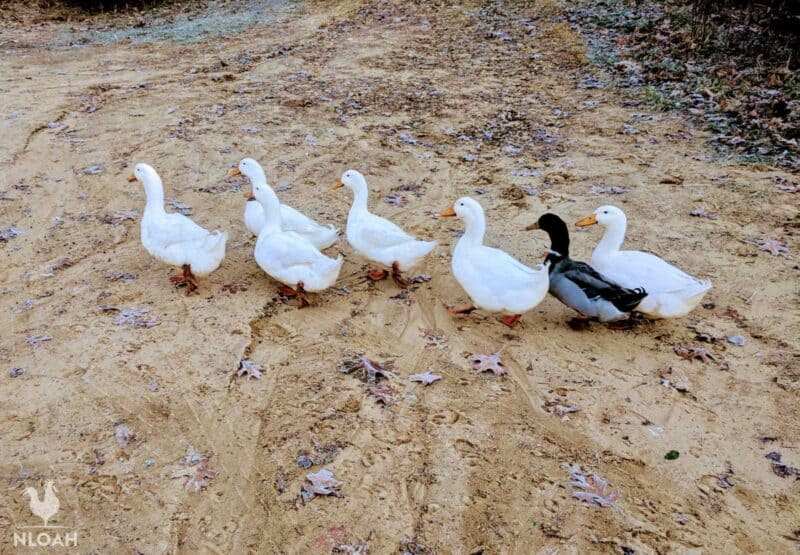
Getting a duck to lay large creamy eggs is a rather simple affair, but some breeds are more adept at the process than others.
You do not need a drake (mature male duck) to garner eggs to eat, only fertilized ones that will produce cute little fuzzy chicks.
One of the major advantages of keeping ducks for eggs is the docile nature of drakes. There will be no worries about getting viciously attacked by a rowdy rooster if you want to raise ducks for egg, meat, or breeding purposes.
Duck eggshells aren’t just larger than the eggs laid by chickens, they are typically hardier as well. One of the easiest ways to maximize egg production in ducks is to allow them free-ranging time so they can consume as much of their natural diet as possible.
Ducks are voracious eaters. They can rid an area of tadpoles and slugs in just a single day when allowed to roam the area in search of food.
The ample protein the duck hens ingest when ridding your land of bugs, combined with a solid supply of calcium in their diet, will help them to produce rich and durable eggs year round.
10 Good Reasons To Raise Ducks For Eggs
- Thanks to their high-fat content and low amount of water, duck eggs are excellent for both baking and cooking. The duck eggs made baked goods especially light and fluffy.
- It is beyond rare for a duck hen to turn broody when laying a clutch of eggs.
- Ducks grow pretty quickly and often start to lay eggs when they are only four to five months old.
- Duck eggs may boast a slightly higher nutrition count than chicken eggs because the whites of the large eggs have an ample supply of protein.
- The shelf life of duck eggs is excellent at up to 6 weeks due to the thickness of both the eggshell and the membranes, as well.
- Quality duck egg-laying breeds can produce between 200 to 350 large eggs each year.
- Ducks are fully capable of producing eggs year-round, even during the winter. While duck egg laying may likely slow down during the coldest months of the year, it would be beyond rare for laying to stop entirely.
- Ducks are more environmentally hardy than chickens, typically. There’s almost always no reason to worry about ducks contracting potentially deadly heat exhaustion or frostbite. They cool themselves in by swimming all summer long and do not have combs and wattles that are susceptible to freezing during the winter.
- Because ducks prefer to be outside the vast majority of the time, not only does the coop remain cleaner, but the spread of bacteria- and fungus-born diseases from extensive coop time during the winter, are rare with duck flocks. It’s not uncommon to see ducks lounging about quite contentedly in the snow and still going swimming during the winter.
- The extremely nitrogen-rich droppings ducks leave on the ground when free ranging makes an excellent compost for garden crops. Setting up a compost mound inside of the duck run where ample droppings will be found even if the flock free ranges the bulk of their day, will provide great starter soil for seeds and young plants.
Is It Hard To Raise Ducks To Produce Eggs?
Ducks are generally easy keepers. They are independent poultry birds that rely very little on human intervention, especially when allowed to free range.
These egg producers are known for their robust immune systems, docile nature, and ease of training. They are also extremely routine-driven. Any deviation from their standard feed, turn out, put up, or snack time will be met with loud quacking until they get their way.
Keeping your husbandry routine on a set schedule will provide stability to the flock and negate the bulk of the quacking you hear from the birds.
Domesticated ducks are very vulnerable to predators because they cannot truly fly, so keep that in mind.
How Many Ducks To Keep For A Steady Supply Of Eggs?
Ducks live in a flock like chickens and guineas. They are definitely social critters that need to be in a communal environment.
Keeping just one duck hen to use as both a farm pet and an egg layer is highly discouraged. You should never keep fewer than three ducks so a flock environment is facilitated.
A small flock of 6 ducks is highly recommended. A ratio of one drake for every four hens will prevent overbreeding along with the stress and potential injury of an egg layer that is overworked by a drake.
A Few of the Best Egg-Laying Duck Breeds
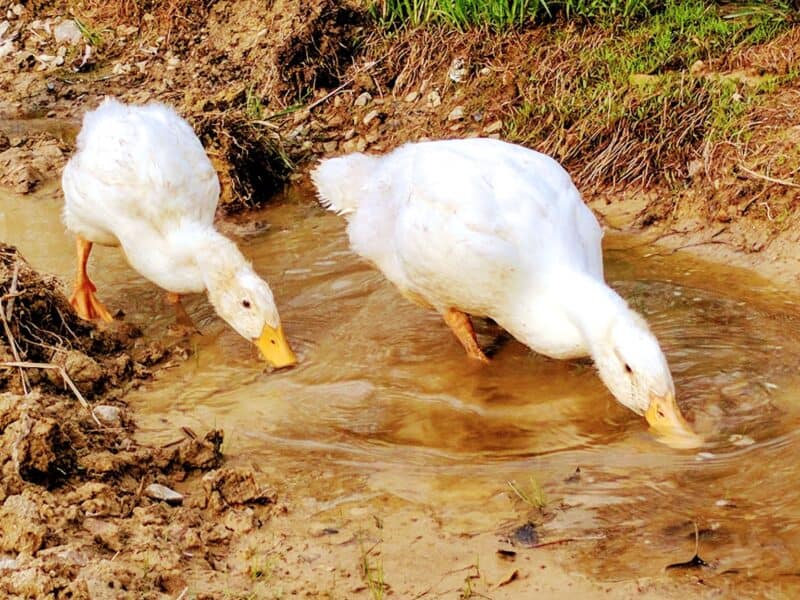
Pekin
Both the standard and jumbo versions of the Pekin duck breed routinely offer up 200 to 250 large white eggs annually. While duck hens from this breed are exceptionally consistent layer year round, they are rarely good sitters.
If you want to grow the numbers of your duck flock and sustain egg laying for the long term future, Pekin duck eggs will likely need to be incubated in order to hatch.
Pekin ducks are among the most popular for farmers and homesteaders who want a highly trainable and dual-purpose poultry bird.
Khaki Campbell
Khaki Campbells hens lay even more large white eggs than Pekin ducks. Hens of this breed should be expected to lay approximately 340 eggs each year. These hens are not only great layers but reliable sitters, as well.
Ducks of this breed are not usually flock leaders like the Pekins, nor are they as predator-aware, in my personal experience. Khaki Cambell ducks are hardy and make great followers in an established flock during free-range training.
Indian Runners
Duck hens from this breed lay roughly 300 eggs per year. Like the Khaki Campbell ducks, they are also exuberant foragers. Indian Runner ducks prefer to free range, but can also live happily in a spacious coop and run environment.
Some of the favorite insect meals of an Indian Runner duck include small reptiles and snails. This quality duck egg-laying breed was used in China for centuries to roam about rice paddies to protect the marshy land from these and other destructive creatures as well as from invasive weeds that could smother the crop.
Indian Runners are also often heralded for their friendly demeanor with keepers as well as their intellect. Indian Runners are also substantially climate-hardy.
Ancona
The Ancona breed is known not just as excellent egg layers but as tasty meat birds, as well. Each year an ancona hen could be expected to produce around 240 duck eggs.
In general, Ancona ducks are known to be especially friendly with their keepers. These very social ducks are so large that they are less likely to be snatched by hawks even prior to reaching full maturity.
While they can live contently inside a large coop and run, Ancona ducks are far happier and more productive if they are allowed to free range.
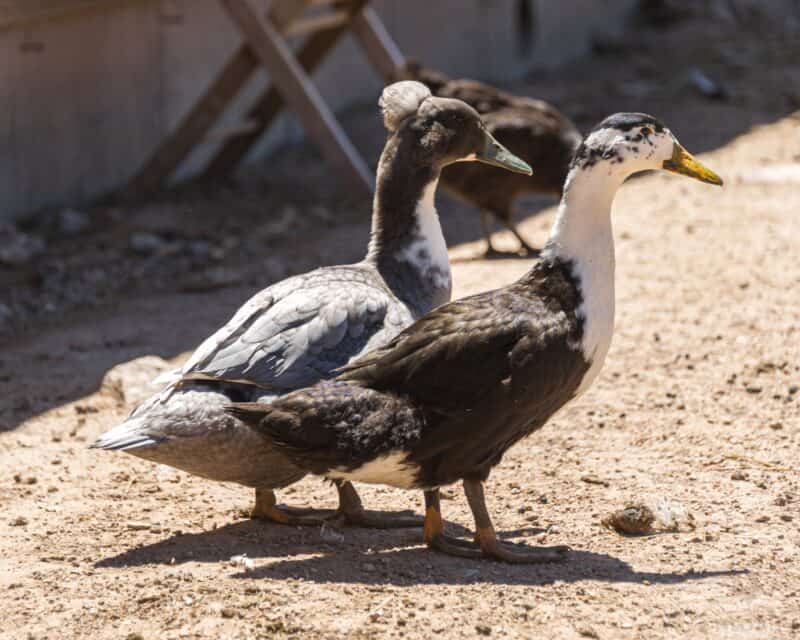
Magpies
This traditional duck egg breed routinely produces about 290 large eggs annually. Eggs from Magpie duck hens are as beautiful as they are tasty. The eggs vary in hue from deep cream to shades of both blue and green.
Magpie ducks can be a little high-strung and may be best coop and run-kept. While they are not known for being lovingly social with their keepers, they are an extraordinarily quiet breed.
These ducks are not only a really quiet breed, they’re also known to be incredibly easy keepers. Duck husbandry newbies that want to collect between 200 and 250 eggs each year should strongly consider keeping Buff Orpingtons.
Ducks from this breed are equally happy in a spacious coop and run environment or free ranging. They often imprint heavily on their keepers and are quite social poultry birds.
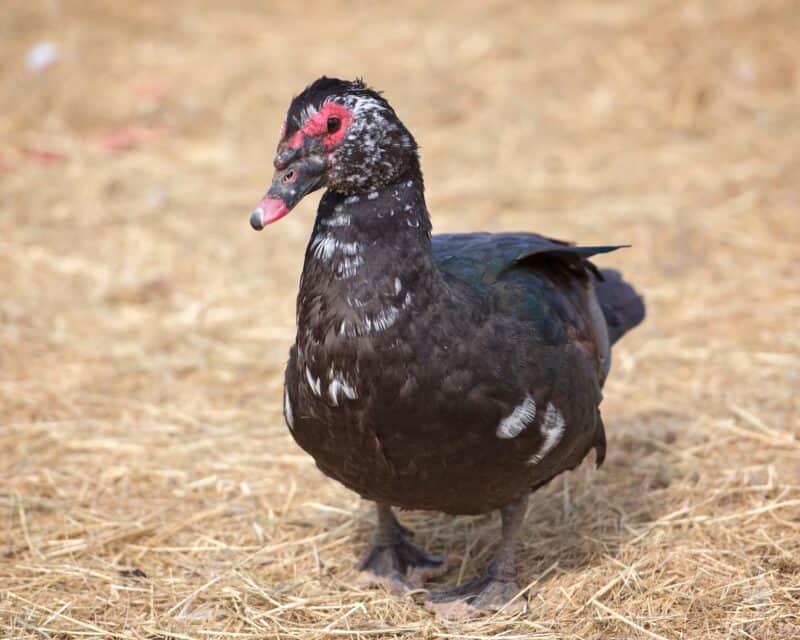
Muscovy Ducks
The Muscovy duck has been domesticated since before Columbus came to the Americas – the breed being first domesticated by local Native American tribes.
They do well in cold weather and can handle temperatures as low as 10 degrees Fahrenheit. The hens will lay a clutch of 8 – 10 white eggs. Additionally, they make for great pest control.
When Do Ducks Start Laying Eggs?
Exactly when a duck starts to lay eggs varies by breed. On average, all duck breeds reach sexual maturity before they are 7 months old. The time of year a duckling is hatched plays a role in how quickly they reach sexual maturity.
Ducklings hatched from April through July are born at a time when the days are long, helping them mature more quickly. Just as sunlight is vital to egg production, it is important to a duck’s growth rate, as well.
Ducklings that are born from late September through January will most often take up to two months longer to mature because the days are far shorter this time of year.
The first few eggs a recently mature duck hen will lay will resemble a chicken egg in size. Even if the first several eggs laid are fertilized, the hatchability rate for any ducklings housed inside will be extremely low.
When Should I Collect Duck Eggs?
Ducks almost always lay their eggs between sunset and 7 am in the morning. If you collect eggs at the same time every day there should never be a worry about missing valuable duck eggs. Yes, duck hens will nearly without fail lay within the noted time frame every time they are ready to release an egg.
Chicken hens, on the other hand, lay on a 25-hour cycle, so there is no telling when each one will drop an egg.
The only downside to duck egg collection is in fact, the collection part. Unlike chicken hens that favor laying eggs in their nests, duck hens will drop an egg anywhere they feel like or happen to be at the moment.
Just decide you are enjoying an Easter egg hunt every morning and embrace the egg dispersal habits of duck hens with a smile.
This is really the best mindset because training a duck hen to lay eggs only in a nest is just never going to happen.
Maximizing Duck Egg Production
Disclosure: if you visit an external link in this post and make a purchase, I may earn a commission. Read my full earnings disclosure here.
Increase Light Exposure
As noted above, adding light to the coop during cold weather months will help foster better egg production. The inexpensive artificial solar light sources can safely infuse the rays needed to simulate the natural light needed to lay eggs as long as the fixture uses a 40 to 60-watt bulb.
When such a light is installed in the coop, the ducks should be laying up to 90% of their normal production rate within four to six weeks.
Nutrient Intake
Boost the calcium and protein intake of the duck laying hens to help maintain and improve laying quantity as well as quality. Egg shells can become far more brittle when the hen’s intake of protein or calcium has waned. Consider giving free choice treats that include mealworms, crushed egg shells, fresh veggies, and fruit.
Cleanliness
Keep the coop, run, and nesting boxes as clean as possible. Hens will refuse to lay in a dirty area, especially in a less-than-hygienic nesting box.
Also, keep all the water sources inside the run clean to help the duck flock members maintain good health. An unhealthy duck will not lay the same quality and quantity as a healthy hen.
Check the size of the nesting box when the hen spends time in it to make sure it is large enough to house both the duck and the eggs while allowing freedom of movement, as well. If the hen feels cramped, she will not sit in the nesting box.
Room To Roam
In my experience, free-ranging can substantially help maximize egg laying. The more natural the environment the duck-laying hens are in, the more comfortable they will be – and that helps maintain and enhance egg production.
If you cannot free range, then create a run on the coop or duck house that is as large as possible and include plantings or edible landscaping and as big of a water feature for swimming as possible.
If you are concerned about predators, especially hawks if you are raising ducks small enough that can be lifted (or have ducklings running about) consider placing bird netting over the duck pond by attaching it to the top of T-posts or wood stakes to help keep the birds better protected while they swim.
As an added bonus, allowing the ducks to either free range or go for waddles around the yard under your supervision will truly go a long way in combating flying and crawling pests.
The lack of mosquitoes and ticks here on our homestead in the middle of the woods – which includes a big pond near the coop and house, is a testament to a free-ranging duck’s ability to reduce the small pest population.
Health Checks
Conduct regular health checks to determine if an injury or illness could be impacting duck egg production. I keep a record of the habits and health check results of each bird.
Doing something as simple as checking over their bodies and feet for wounds, signs of parasites, or extensive feather plucking can help you recognize a small issue before it becomes a huge or – or worse yet, one that spreads from a single duck laying hen to the rest of the flock.
Monitor the water and food intake as well. If you notice the flock is consuming less of either (or both) that might indicate an illness or parasite infestation.
Secure Coop and Run
Sometimes a keeper thinks the duck hens are not laying eggs because the number of eggs being collected has diminished when the birds are in fact still laying normally.
In cases like this, the eggs are actually being stolen by predators. A mink, rat, snake, or raccoon can make short work of wire enclosures. Such wire works fine to keep poultry birds in but has little to no success at keeping predators out.
In addition to a good fence, hardware cloth on the sides and top of run and layered on the base of the coop can keep climbing and clawing, slithering, and burrowing predators away from your nesting boxes.
A raccoon can often open a simple one-step lock, so a two-step lock that requires more mechanical skill than a raccoon possesses should be used.
Relieve Stress
A stressed duck will simply not lay eggs, or at least not lay as many eggs as it would otherwise.
Ducks are a bit more susceptible to predators (i.e. coyotes) than chickens, but in my experience, hardier birds to keep when it comes to times of both intense heat and cold.
Because a duck laying hen’s beak cannot peck even a small predator and it cannot really fly up and away, it is unable to defend itself – hence the phrase, “sitting duck.”
Consider investing in a livestock guardian dog to help keep the coop and duck pond area free of predators.
Even if you live in a small town or suburbia and not on a rural homestead, there can still be deadly predators lurking about that can kill your duck-laying hens. Keeping a livestock guardian dog or some guineas can vastly help to protect your egg-laying ducks.
Any one of the top egg-laying duck breeds highlighted in this guide will provide frequent and quality eggs for your family.
Choosing the right breed to suit your particular space limitations and husbandry plan will vastly increase your chances of success.
Following the outlined habitat setup protocols and diligently conducting weekly checks on the birds will help keep your duck hens happy, clean, healthy, and producing large and creamy rich eggs year-round.
Use Solar Lights in the Coop
Hang a solar-powered coop light inside either the coop itself or the run – or both, to encourage consistent egg laying even during cold weather months.
Providing up to 14 hours of light to the duck hens with a 40 to 60 watt bulb can help the hens get up to 90 percent laying capacity after just a few weeks of exposure.
Add More Protein and Calcium
Infusing more protein and calcium into a duck hen’s diet and/or using a breeder hen fee will help the poultry birds maintain the prime nutrient balance needed for peek laying and reproductive abilities.
Maintain Proper Ratio
Maintain the proper one-drake to three-hen flock ratio if you are keeping drakes. Even if hatchling a lot of ducklings is not your primary goal, hens will become overly stressed or even injured if constantly subjected to the rather rough tactics involved with duck mating.
A stressed or injured hen will not be a solid egg producer, no matter what breed of poultry bird you choose to keep.
Nesting Boxes for Drakes
The ducks should be provided with nesting boxes even if they may only sporadically use them. I have found that my duck hens will lay eggs all over the place but then pack and roll them back to the nest for sitting – until they get bored with the process and go for a swim.
Some hens will lounge in the nesting box to get away from an overly amorous drake or to feel calm and safe until right before an egg is laid. Duck hen nesting boxes should be one foot wide, one foot deep, and 18 inches long.
Give Them Enough Feed
Providing the duck hens with the proper quantity of feed is also extremely important. Ducks should not be permitted to become overweight. They should have no more than .35 pounds of feed per bird available on a daily basis. Both egg production and fertility will decrease in overweight hens.
Once the hens have become established layers and you are getting at least four eggs from 8 to 10 hens on a daily basis, they can have more open access to feed – with weight gain always being monitored.
Most duck breeds will lay an egg every day until the hen believes she has a complete clutch for sitting – even if the breed is lousy at sitting. If the hen sits her eggs, even for a little while, she will rotate the eggs in the nest.
The female duck will shift the eggs around on a regular basis, in an effort to make sure her body heat has been distributed evenly – which is essential for hatching purposes.
Most domesticated duck breeds lay eggs in clutches (or batches) of 20. The first several eggs laid, especially from a recently mature bird, will be smaller than the rest of those in the same clutch.
These small eggs are often referred to as “fairy eggs” by keepers. Once the bird has matured and continues to fill out her clutch, the fairy eggs, which are as safe to eat as the other eggs, should dissipate. Hatching a fertilized fairy egg often does not produce successful results.
While it varies slightly between breeds, you should expect a duck hen to begin laying her first eggs once she reaches six to seven months old.
Some duck breeds are better at laying during the cold weather months than others. You will increase the chances of ducks laying during the winter if you keep a coop light from the late fall through the early spring.
Poultry birds need at least eight if not 10 hours of sunlight per day to foster good egg laying with respect to both quantity and quality. Thin shells often develop when the birds lay eggs during the winter.
Solar-powered little coop lights that can be hung inside the coop cost around $10 to $15 each. Unlike brooder lights, they do not produce heat or intense power that could cause dry bedding to catch on fire.
Both types of poultry bird eggs taste basically the same, but duck eggs are known to have a creamy texture and a more rich flavor. Both the yolks and the eggs themselves are larger when laid by a duck hen – even a banty duck breed.
Bakers tend to love duck eggs, both amateur and high-end professional ones, because of the way yolks from duck eggs “stand up” to produce “loft” and the way the creamy texture makes dishes far moister. Duck eggs are most often used in custards, cakes, cookies, and pies.
You can cook a duck egg just as you would a chicken egg. They taste great scrambled, fried, poached, or hard-boiled. Expect the large yolk in the duck egg to have a deeper red-to-orange hue when cooking with it.
The typical duck egg is approximately 30% larger than a chicken egg. When baking or cooking with a duck egg the general rule of thumb is to substitute two duck eggs for every three chicken eggs a recipe calls for.
Some folks use a one-to-one substitution ratio if a recipe calls for a large egg specifically, but doing so could run the risk of the dish or baked goods being a little runny.
Magpies, Anaconas, and Indian Runnerslay colored eggs. Ducks that lay colored eggs are commonly referred to as “Easter eggers.”
Some folks keep ducks of this type simply because of the beauty of their eggs to use at Easter time in the spring even though they may not lay as many eggs year-round as some other breeds. Duck eggs that are colored are often sought after by artisans who purchase them for painting and other crafting projects.
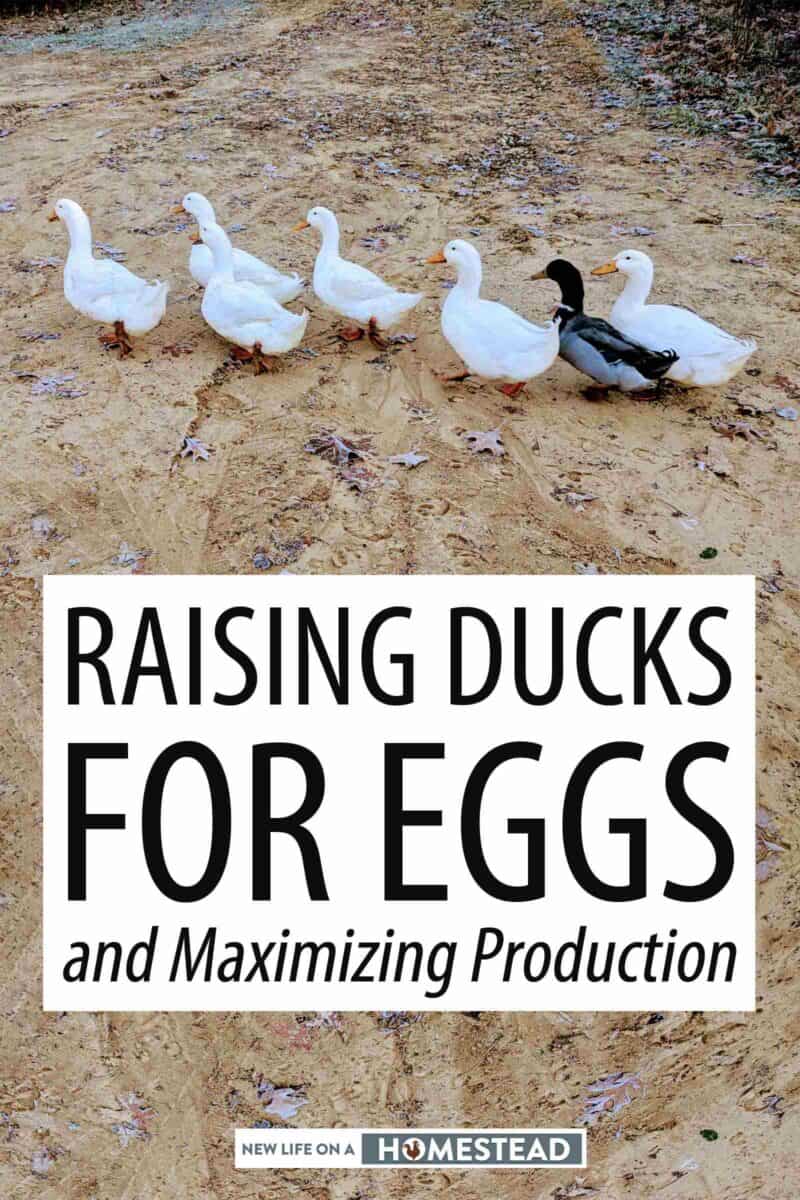

Tara lives on a 56 acres farm in the Appalachian Mountains, where she faces homesteading and farming challenges every single day, raising chickens, goats, horses, and tons of vegetables. She’s an expert in all sorts of homesteading skills such as hide tanning, doll making, tree tapping, and many more.
